MaryAnn Bernal's Blog, page 173
June 3, 2015
1,400-year-old medicinal treatise of Galen found hidden under hymns in ancient manuscript
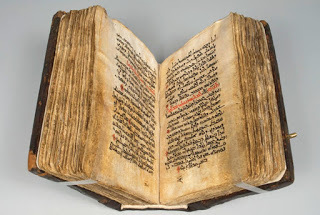 Ancient Origins
Ancient OriginsA 6th century translation of a work of one of the most important ancient Greek doctors has been discovered in an animal-hide manuscript, hidden underneath text of 1,000-year-old hymns. A researcher told The New York Times that Galen's ideas on medicine were “completely bonkers,” but the palimpsest text holds important clues on how the ancients treated patients.
Galen, born in 131 AD, was considered one of the greatest practitioners of medicine in the ancient world, both East and West, through to the 16th century. Legend has it that Galen eviscerated an ape in front of the High Priest of Asia in Pergamon and challenged other doctors that were present to repair it. They could not, so Galen did, thereby gaining his post as physician for the high priest's gladiators. In 170 AD he became physician to Commodus, who became emperor in 180 AD.
“The Galenic system is completely bonkers,” Dr. Siam Bhayro, a Jewish studies scholar in England, told The New York Times.
Roseroot, an ancient remedy for fatigue and disease, gets new respect Asklepion and the use of Dreams for curing diseases with the help of the Gods Medieval Medicine: 1,000-year-old Onion and Garlic Salve Kills Modern Bacterial SuperBugs
 “Wound Man,” a medieval work attributed to Galen (Wikimedia Commons)That said, the website Medscape indicates Galen understood more about physiology than Aristotle. Aristotle said the heart was more important than the brain, while Galen said the brain was the primary organ, controlling all the other organs of the body. Both men were right in a way because the brain cannot function without the blood and oxygen that the heart pumps to it. But Aristotle's idea was that the brain's main purpose was to produce phlegm to cool the heart. Galen showed more understanding when he said the brain was connected to and controlled the entire body. He wrote, "If you press so much upon a cerebral ventricle that you wound it, immediately the living being will be without movement and sensation, without spirit and voice."
“Wound Man,” a medieval work attributed to Galen (Wikimedia Commons)That said, the website Medscape indicates Galen understood more about physiology than Aristotle. Aristotle said the heart was more important than the brain, while Galen said the brain was the primary organ, controlling all the other organs of the body. Both men were right in a way because the brain cannot function without the blood and oxygen that the heart pumps to it. But Aristotle's idea was that the brain's main purpose was to produce phlegm to cool the heart. Galen showed more understanding when he said the brain was connected to and controlled the entire body. He wrote, "If you press so much upon a cerebral ventricle that you wound it, immediately the living being will be without movement and sensation, without spirit and voice."Peter Pormann, a Greco-Arabic scholar in Manchester, England, called the find important on many levels. “It’s likely to be a central text once it’s fully deciphered. We might discover things we really can’t dream of yet,” he told The New York Times.
 A scan of a folio from the text, which is available online at http://digitalgalen.net/.The 230-folio parchment palimpsest includes one of Galen's medical texts that was not entirely lost in antiquity, though 125 of his books were lost in a fire.
A scan of a folio from the text, which is available online at http://digitalgalen.net/.The 230-folio parchment palimpsest includes one of Galen's medical texts that was not entirely lost in antiquity, though 125 of his books were lost in a fire.Books 6 to 8 of the text, On the Mixtures and Powers of Simple Drugs, are in the British Library. But the new find, which will provide much more material, is an earlier translation, from ancient Greek to Syriac. This translation may differ from later ones and be truer to what Galen actually wrote. The differences between known translations and this latest find, a 9th century copy of a 6th century translation, may help show how doctors treated patients in antiquity.
Though the text has been known since the 2000s, scholars are just beginning to study it. The New York Times says the text may provide previously unknown information about how the practice of medicine developed and spread.
The book is owned by a man in Baltimore, a collector of rare scientific material. Grigory Kissel, a German language scholar, was examining the manuscript at the collector's house when he saw how similar it was to a page he had held Harvard University a little while before. Kissel realized how important the find was.
That was in February 2013. Between then and May 2015 a worldwide search for seven missing pages ended when the final page was digitized in Paris, The New York Times reported. One page of the manuscript remains at St. Catherine's Monastery in the Sinai Desert. Three others were in a Vatican library.
 St. Catherine's Monastery from Mount Sinai in Egypt; the monastery has the oldest continuously operating library in the world. (Photo by Wilson44691/Wikimedia Commons)The Digital Galen Syriac Palimpsest has all of the folios online. They were scanned using special techniques at the Walters Art Museum in Baltimore. An introduction on the website says: “This manuscript contains an eleventh-century liturgical text that is very important for the study of the hymns of Byzantine and Melkite Christianity. The manuscript's value is further increased by the fact that it is a palimpsest, with an older and very significant undertext. The undertext dates back to approximately the ninth century, and contains Syriac translations of Greek medical texts. Preliminary investigations have identified several leaves from Galen's major pharmacological treatise.”
St. Catherine's Monastery from Mount Sinai in Egypt; the monastery has the oldest continuously operating library in the world. (Photo by Wilson44691/Wikimedia Commons)The Digital Galen Syriac Palimpsest has all of the folios online. They were scanned using special techniques at the Walters Art Museum in Baltimore. An introduction on the website says: “This manuscript contains an eleventh-century liturgical text that is very important for the study of the hymns of Byzantine and Melkite Christianity. The manuscript's value is further increased by the fact that it is a palimpsest, with an older and very significant undertext. The undertext dates back to approximately the ninth century, and contains Syriac translations of Greek medical texts. Preliminary investigations have identified several leaves from Galen's major pharmacological treatise.”Featured image: The medical text dates to the 9th century, the hymn book to the 11th century. (Walters Art Museum photo)
By Mark Miller
Published on June 03, 2015 07:26
History Trivia - Thomas À Becket consecrated Archbishop of Canterbury
June 3
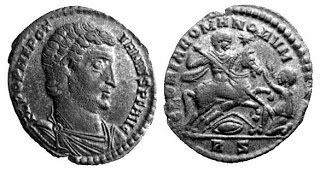
350 Roman usurper Nepotianus, of the Constantinian dynasty, proclaimed himself Roman Emperor, entering Rome at the head of a group of gladiators.

1083 Henry IV of Germany stormed Rome, capturing St Peter's Cathedral.
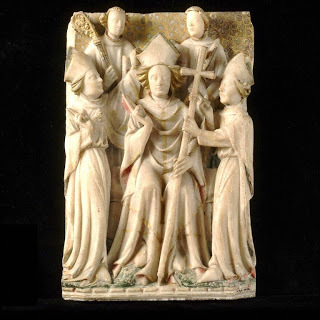
1162 Thomas À Becket consecrated Archbishop of Canterbury.

350 Roman usurper Nepotianus, of the Constantinian dynasty, proclaimed himself Roman Emperor, entering Rome at the head of a group of gladiators.

1083 Henry IV of Germany stormed Rome, capturing St Peter's Cathedral.

1162 Thomas À Becket consecrated Archbishop of Canterbury.
Published on June 03, 2015 03:00
June 2, 2015
History Trivia - Geiseric the Vandal sacks Rome
June 2

455 Geiseric the Vandal sacked Rome.
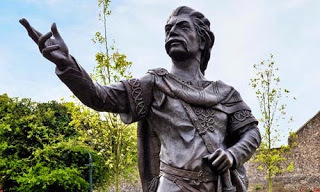
597 Saxon King Ethelbert was the first English King to convert to Christianity and baptized by St. Augustine of Canterbury.
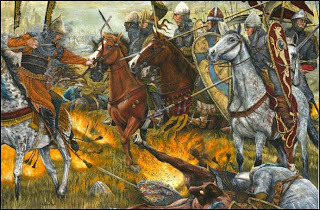
1098 First Crusade: The first Siege of Antioch ended as Crusader forces took the city. The second siege began on June 7.

455 Geiseric the Vandal sacked Rome.

597 Saxon King Ethelbert was the first English King to convert to Christianity and baptized by St. Augustine of Canterbury.

1098 First Crusade: The first Siege of Antioch ended as Crusader forces took the city. The second siege began on June 7.
Published on June 02, 2015 02:30
June 1, 2015
History Trivia - Friar John Cor records the first known batch of Scotch Whisky
June 1
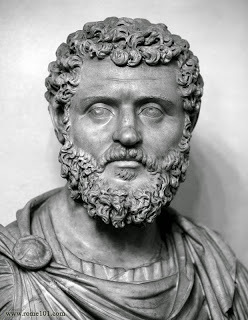
193 Roman Emperor Didius Julianus was assassinated.
 1495 Friar John Cor (Lindores Abbey, Scotland) recorded the first known batch of Scotch Whisky.
1495 Friar John Cor (Lindores Abbey, Scotland) recorded the first known batch of Scotch Whisky.
 1533 Anne Boleyn was crowned Queen of England.
1533 Anne Boleyn was crowned Queen of England.

193 Roman Emperor Didius Julianus was assassinated.
 1495 Friar John Cor (Lindores Abbey, Scotland) recorded the first known batch of Scotch Whisky.
1495 Friar John Cor (Lindores Abbey, Scotland) recorded the first known batch of Scotch Whisky.
 1533 Anne Boleyn was crowned Queen of England.
1533 Anne Boleyn was crowned Queen of England.
Published on June 01, 2015 02:00
May 31, 2015
History Trivia - Big Ben rings out for the first time
May 31,

1279 BC – Ramses II (The Great, 19th dynasty) became pharaoh of Ancient Egypt.
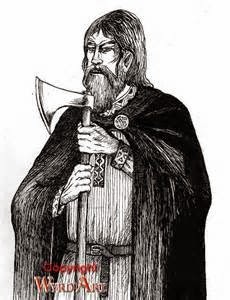
1076 The execution of Waltheof of Northumbria ended the 'Revolt of the Earls' against William the Conqueror.

1859 Big Ben, located atop St. Stephen's tower, went into operation in London, ringing out over the Houses of Parliament in Westminster, London for the first time.

1279 BC – Ramses II (The Great, 19th dynasty) became pharaoh of Ancient Egypt.

1076 The execution of Waltheof of Northumbria ended the 'Revolt of the Earls' against William the Conqueror.

1859 Big Ben, located atop St. Stephen's tower, went into operation in London, ringing out over the Houses of Parliament in Westminster, London for the first time.
Published on May 31, 2015 00:30
May 30, 2015
History Trivia - Henry VIII marries Jane Seymour
May 30,

70 Siege of Jerusalem: Titus and his Roman legions breached the Second Wall of Jerusalem. The Jewish wars financed the construction of the Flavian Amphitheater, which took ten years to build.

1536 King Henry VIII of England married Jane Seymour, a lady-in-waiting to his first two wives.
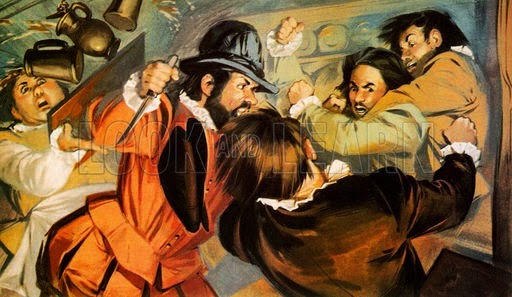
1593 Leading Elizabethan playwright Christopher Marlowe was stabbed to death in a pub brawl in Deptford.

70 Siege of Jerusalem: Titus and his Roman legions breached the Second Wall of Jerusalem. The Jewish wars financed the construction of the Flavian Amphitheater, which took ten years to build.

1536 King Henry VIII of England married Jane Seymour, a lady-in-waiting to his first two wives.

1593 Leading Elizabethan playwright Christopher Marlowe was stabbed to death in a pub brawl in Deptford.
Published on May 30, 2015 00:30
May 29, 2015
History Trivia - Byzantine Empire ends
May 29,
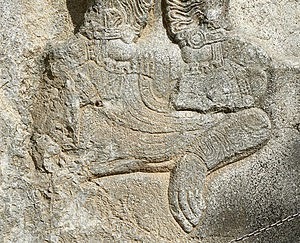
363 Roman Emperor Julian defeated the Sassanid army in the Battle of Ctesiphon, under the walls of the Sassanid capital, but was unable to take the city.

1167 Battle of Monte Porzio – A Roman army supporting Pope Alexander III was defeated by Christian of Buch and Rainald of Dassel.
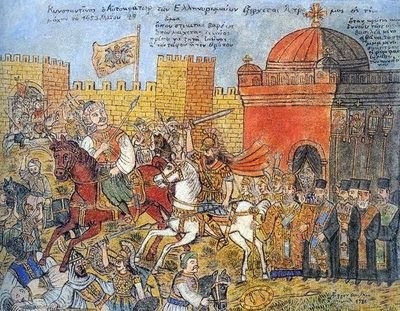
1453 The Roman Empire in the east (Byzantine Empire) came to an end as Ottoman sultan Mehmet II captured Constantinople.

363 Roman Emperor Julian defeated the Sassanid army in the Battle of Ctesiphon, under the walls of the Sassanid capital, but was unable to take the city.

1167 Battle of Monte Porzio – A Roman army supporting Pope Alexander III was defeated by Christian of Buch and Rainald of Dassel.

1453 The Roman Empire in the east (Byzantine Empire) came to an end as Ottoman sultan Mehmet II captured Constantinople.
Published on May 29, 2015 00:30
May 28, 2015
Mystery Deepens Over Rare Roman Tombstone
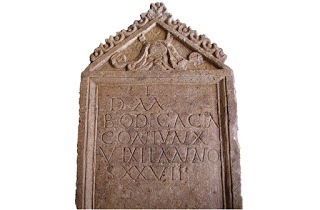
Detail of the mysterious Roman inscription. Cotswold Archaeology
Discovery News
Mystery has deepened over a Roman tombstone unearthed earlier this year in western England, as new research revealed it had no link with the skeleton laying beneath it.
The inscribed stone was discovered during the construction work of a parking lot in Cirencester.
Made from Cotswold limestone, it was found laying on its front in a grave — directly above an adult skeleton.
Pompeii Couple Reunited in Marble Inscription When it was turned over, the honey colored stone revealed fine decorations and five lines of Latin inscription which read: “D.M. BODICACIA CONIUNX VIXIT ANNO S XXVII,” possibly meaning: “To the shades of the underworld, Bodicacia, spouse, lived 27 years.”
The discovery was hailed as unique since the stone was believed to be the only tombstone from Roman Britain to record the person found beneath.
In fact, while the dedication on the tombstone is to a woman, the skeleton beneath it was that of a male.
Ancient Greek Tombstones Served as Therapy
It turns out the gravestone and skeleton were also laid at different times — the inscribed stone was early Roman, dating to the 2nd century A.D., while the burial was most certainly late Roman, from the 4th century A.D..
“We believe the tombstone to have been re-used as a grave cover perhaps as long as two centuries after it was first erected,” Ed McSloy, Cotswold Archaeology’s finds expert, told Discovery News.
Martin Henig and Roger Tomlin, leading experts in Roman sculpture and inscriptions at the University of Oxford, noted that the back of the stone is very roughly worked, almost unfinished, in strong contrast to the finely sculpted front.
Unlikely to have been a free-standing tombstone, the five-foot-long inscribed stone may have rather been set into walls, possibly those of a mausoleum.Who the grave belonged to remains a mystery.
“Reading the letters, the most plausible interpretation of the name is Bodicacia, a previously unknown Celtic name,” McSloy said.
Gladiator Chews Out Ref From Grave
Indeed the name appears to be a variant of a Celtic name with same root as Boudicca. This was the rebel queen of the Iceni, a British tribe, who unsuccessfully attempted to defeat the Romans.
Bodicacia’s tombstone was also unique. The pediment, which is the decorated, triangular portion at top of the stone, shows the Roman god Oceanus.
A divine personification of the sea in the classical world, the god was portrayed with a long mustache, stylized long hair, and crab-like pincers above the head.
‘For Allah’ Inscription Found on Viking Era Ring
The image, according to McSloy “is also hitherto unknown in funerary sculpture.”
Most likely, Bodicacia was deprived of her unique tombstone sometime in the fourth century, when her funerary stone was buried in a grave. At the same time or before this date, Oceanus was deliberately defaced.
“The most likely context for this would be early Christian iconoclasm,” McSloy said.The tombstone will be soon put on permanent display at Cirencester’s Corinium Museum.
Published on May 28, 2015 10:52
Saxon butter churn found in Staffordshire sheds light on life in Mercian Kingdom
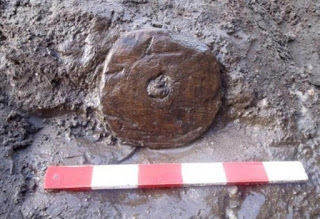 Ancient OriginsArchaeologists working on the site of a rail improvement project in the UK have discovered the lid of a butter churn from the Saxon period.
Ancient OriginsArchaeologists working on the site of a rail improvement project in the UK have discovered the lid of a butter churn from the Saxon period.The discovery of a wooden object at Norton Bridge, reported in the Staffordshire Newsletter, was made on the site of a new flyover currently being constructed by Network Rail along with 11 new bridges. The work is being carried out in order to remove a bottleneck on the busy West Coast Main Line.
The artifact was discovered among the remains of worked wooden stakes and wood chips on waterlogged peat near Meece Road, just south of Yarnfield in Staffordshire. Radiocarbon tests have dated the wooden lid to 715 to 890 AD when the area was part of the Saxon kingdom of Mercia. The results show that the artifact is roughly the same age as the famous Staffordshire Hoard, the largest collection of Anglo-Saxon gold found anywhere in the world.
 The Staffordshire Hoard, discovered in a field in Hammerwich, near Lichfield in July 2009, is perhaps the most important collection of Anglo-Saxon objects found in England. 2009, David Rowan, Birmingham Museum and Art Gallery. (
en.wikipedia.org
)Archaeologists originally believed the lid to be far older, as evidence of prehistoric occupation has been discovered nearby. Furthermore, no pottery or other metalwork was found on the site, which could have helped to date the artifact. Dr Emma Tetlow of Headland Archaeology said she was delighted by the find as precious little evidence of the Mercian kingdom has been discovered in the UK so far. Wooden artifacts and other organic evidence from the Saxon period are very rare indeed.
The Staffordshire Hoard, discovered in a field in Hammerwich, near Lichfield in July 2009, is perhaps the most important collection of Anglo-Saxon objects found in England. 2009, David Rowan, Birmingham Museum and Art Gallery. (
en.wikipedia.org
)Archaeologists originally believed the lid to be far older, as evidence of prehistoric occupation has been discovered nearby. Furthermore, no pottery or other metalwork was found on the site, which could have helped to date the artifact. Dr Emma Tetlow of Headland Archaeology said she was delighted by the find as precious little evidence of the Mercian kingdom has been discovered in the UK so far. Wooden artifacts and other organic evidence from the Saxon period are very rare indeed.“During this period this part of Staffordshire was part of the Mercian heartland and was populated by a pagan tribe called the Pencersaete” said Dr Tetlow. “Existing knowledge of this period for the north and east of the Midlands and the UK in general is very scarce, so this find is fantastic and of regional significance.”
Dr Tetlow said that the climate of the area at that time would not have been too different from that experienced by people in the UK today as the country was becoming affected by dynamic climate change at the start of what is now known as the ‘Medieval Warm Period’. This was a short climatic interval that is thought to have taken place roughly between 900 and 1300 AD, predominantly affecting the Northern Hemisphere. The Pencersaete would therefore have had to endure unsettled and stormy weather including flooding and a general increase in temperature.
Amazing Find with a Metal Detector - The Incredible Staffordshire Anglo-Saxon Gold Hoard Waves of invaders came to Britain but left few genes, new study says Archaeologists find 'lost village' in Nottinghamshire, England
 Map of England showing where Mercia was located in the 700-late 800’s. (
Wikimedia Commons
)Butter churns were containers, looking much like a wooden barrel, used to convert cream into butter. They had a hole in the lid through which a pole was inserted. This was then used to agitate the cream in order to disrupt the milk fat, the membranes of which break down thereby creating lumps called butter grains. These join with each other to form larger globules and when the air is forced out of them the mixture becomes buttermilk. Constant and continued churning forces the globules together to form butter. Consumption of butter can be traced as far back as 2000 BC.
Map of England showing where Mercia was located in the 700-late 800’s. (
Wikimedia Commons
)Butter churns were containers, looking much like a wooden barrel, used to convert cream into butter. They had a hole in the lid through which a pole was inserted. This was then used to agitate the cream in order to disrupt the milk fat, the membranes of which break down thereby creating lumps called butter grains. These join with each other to form larger globules and when the air is forced out of them the mixture becomes buttermilk. Constant and continued churning forces the globules together to form butter. Consumption of butter can be traced as far back as 2000 BC. Butter churning equipment with all the features for churning, storing, and processing. At the Beskid Museum in Wisła. Photo by Piotrus, 2008. (
Wikimedia Commons
)The archaeologists intend holding an information day when members of the public can view the finds and discuss them with Dr Tetlow and her colleagues. Dr Tetlow is also planning to write a paper on the discovery for the Stafford and Mid-Staffs Archaeological Society.
Butter churning equipment with all the features for churning, storing, and processing. At the Beskid Museum in Wisła. Photo by Piotrus, 2008. (
Wikimedia Commons
)The archaeologists intend holding an information day when members of the public can view the finds and discuss them with Dr Tetlow and her colleagues. Dr Tetlow is also planning to write a paper on the discovery for the Stafford and Mid-Staffs Archaeological Society.Mercia was one of the seven great kingdoms of Anglo-Saxon England, the other kingdoms being East Anglia, Essex, Kent, Northumbria, Sussex and Wessex. It was ruled from a capital at Tamworth and expanded rapidly during the 6th and 7th centuries, becoming one of the ‘big three’ kingdoms alongside Northumbria and Wessex. The first ruler of Mercia was King Icel (515-535 AD) and the last was Queen AElfwynn (918 AD) who was deposed by King Edward the Elder of Wessex when he rode into the kingdom and conquered it. The Anglo-Saxon Chronicle mentions this episode, commenting that “the daughter of Æthelred, lord of the Mercians, was deprived of all dominion over the Mercians, and carried into Wessex, three weeks before mid-winter; she was called Ælfwynn.” Mercia reached its strongest point during the rule of King Offa when the kingdom dominated much of central England.
 King Offa of Mercia from the Benefactors Book of St. Alban's Abbey. C1380. (Wikimedia Commons) The Pencersaete took their name from the Penk Valley, named after a hill near Penkridge. They are named in an Anglo-Saxon charter of 849 describing the area of Cofton Hackett in the Lickey Hills, south of the present city of Birmingham. This region formed the boundary between the Pencersaete and their neighbors, the Tomsaete.
King Offa of Mercia from the Benefactors Book of St. Alban's Abbey. C1380. (Wikimedia Commons) The Pencersaete took their name from the Penk Valley, named after a hill near Penkridge. They are named in an Anglo-Saxon charter of 849 describing the area of Cofton Hackett in the Lickey Hills, south of the present city of Birmingham. This region formed the boundary between the Pencersaete and their neighbors, the Tomsaete.Featured Image: Butter Churn from the Saxon Period, found at Norton Bridge.
Published on May 28, 2015 10:44
History Trivia - Acre falls, ending the Crusades
May 28,

585 BC A solar eclipse occurred, as predicted by Greek philosopher and scientist Thales, while Alyattes was battling Cyaxares in the Battle of the Eclipse, leading to a truce. This was one of the cardinal dates from which other dates can be calculated.
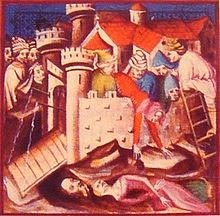
1291 Acre, in the Kingdom of Jerusalem, fell to the Moslems, ending the Crusades.
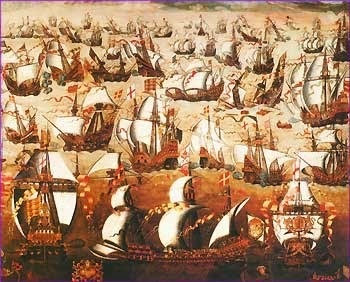
1588 The Spanish Armada, with 130 ships and 30,000 men, set sail from Lisbon heading for the English Channel. (It would take until May 30 for all ships to leave port).

585 BC A solar eclipse occurred, as predicted by Greek philosopher and scientist Thales, while Alyattes was battling Cyaxares in the Battle of the Eclipse, leading to a truce. This was one of the cardinal dates from which other dates can be calculated.

1291 Acre, in the Kingdom of Jerusalem, fell to the Moslems, ending the Crusades.

1588 The Spanish Armada, with 130 ships and 30,000 men, set sail from Lisbon heading for the English Channel. (It would take until May 30 for all ships to leave port).
Published on May 28, 2015 00:30



